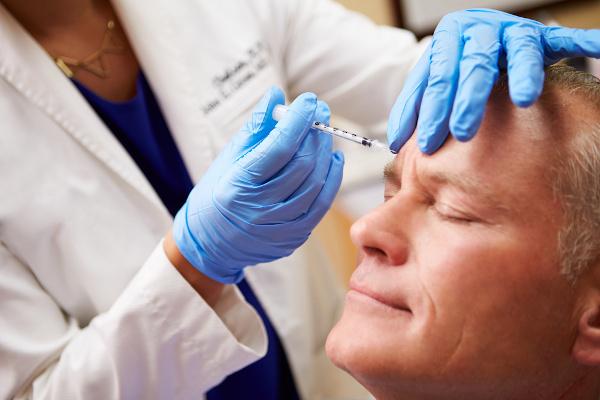Botox® is the first brand of botulinum toxin that was registered and licensed for cosmetic use and stands out for being marketed worldwide. Botulinum toxin became known as botox, due to its popularity.
Botulinum toxin is a neurotoxin widely used for aesthetic purposes, and its application is carried out to prevent signs of aging, such as smoothing expression lines and wrinkles. The application of botulinum toxin can cause adverse effects, however, they are usually transient and mild.
Read too:Aspirin® — the best-known form of acetylsalicylic acid
Topics in this article
- 1 - Summary about Botox®
-
2 - What is Botox®?
- → What is botulinum toxin?
- 3 - How is Botox® treatment performed?
- 4 - What are the uses of Botox®?
- 5 - Does the use of Botox® have risks?
- 6 - Can you administer Botox® during pregnancy?
Botox® Summary
Botox® is a brand of botulinum toxin.
Botulinum toxin is a neurotoxin released by bacteria Clostridium botulinum.
It is injected into our body via intramuscular or intradermal, depending on the area to be treated.
The use of botulinum toxin is a non-surgical procedure.
Botulinum toxin type A is the most used for aesthetic purposes.
Botulinum toxin is widely used in the treatment of wrinkles, but it also has other applications, being used for therapeutic purposes, in the treatment of ophthalmological, dental and even neurological.
As with other medications, the application of botulinum toxin can cause adverse effects, although they are mild.
Do not stop now... There's more after the ad ;)
What is Botox®?
Botox® is the first botulinum toxin brand approved for cosmetic use, produced by the company Allergan. According to the patient leaflet,
Botox ® is a sterile, vacuum-frozen form of botulinum toxin A, produced by culturing the Hall strain of Clostridium botulinum type A, developed in a medium containing casein hydrolyzate, glucose and yeast extract.
→ What is botulinum toxin?
Botulinum toxin is a protein released by the bacteria called Clostridium botulinum, a gram-positive, anaerobic bacterium known primarily to cause a serious disease called botulism.This protein is a neurotoxin, which has eight serotypes, called A, B, Cb, C2, D, E, F and G.
Serotype A is the most used for aesthetic purposes, being considered the most potent. It is widely used in Brazil, with Botox® being the first registered and licensed product. The brand is currently the best known in the country, however, it is not the only one available on the market. Other brands of botulinum toxin are: Dysport®, Xeomin®, Prosigne® and Botulift®.
Important:Because of the first brand of botulinum toxin registered and licensed in Brazil, the toxin is popularly known in the country as “botox”.
How is Botox Treatment Done?®?
Botulinum toxin is applied in small amounts through injections, being a procedure that should only be performed by qualified health professionals. For the treatment of hyperhidrosis, the injections are intradermal, while for other indications the injections must be intramuscular.

The mechanism of action of the toxin based on the reduction of muscle contraction through the inhibition of acetylcholine. By promoting a decrease in muscle tension, the use of botulinum toxin can be recommended for different applications.
Generally, the action of botulinum toxin starts between three and five days after its application, being essential to understand that the result is not permanent, and its effect varies from one patient to another.
What are the uses of Botox?®?
Botulinum toxin is used mainly for aesthetic purposes, being indicated, for example, for soften expression lines and wrinkles andimprove skin healing and gummy smile. Currently, the use of botulinum toxin stands out as one of the most popular non-surgical procedures in our country.
It is worth noting, however, that the use of botulinum toxin not restricted to cosmetic procedures. Regarding Botox®, the manufacturer claims that the drug is indicated for
improvement of spasticity (muscle stiffness) of the neck, arms, hands and legs, of strabismus (alignment deviation between one eye and the other) and of blepharospasm (contraction involuntary) of muscles of the eyelids, face and limbs associated with dystonia, including benign essential blepharospasm or VII cranial nerve disorders in patients over 12 years of age, cervical dystonia, hemifacial spasm, hyperkinetic facial lines (wrinkles), focal hyperhidrosis (excessive sweating), armpits and palms hands, urinary incontinence caused by neurogenic overactivity of the bladder detrusor muscle, overactive bladder with symptoms of incontinence, urgency and increased urinary frequency and chronic migraine (chronic migraine) and refractory with significant impairment of quality of life and daily activities (work, social, family and leisure).
Know more: Penicillin — the first known antibiotic
The use of Botox® have risks?
Despite being considered a safe product, the use of botulinum toxin, like other medications, can cause adverse effects, which may be transitory or lasting. Different reactions can be observed, which are directly related to the site of application of the toxin.
Some of the adverse effects seen after using Botox® are:
local pain;
edema;
drooping eyelid;
eye movement disorders;
difficulty swallowing;
difficulty urinating;
headache;
tingling sensation and sensitivity;
between others.
It is important that a doctor is consulted when unwanted effects are noticed, especially if the patient has difficulty speaking, breathing or swallowing.
Can you administer Botox® During the pregnancy?
According to the package insert for Botox® patients, the use of botulinum toxin should only be performed during pregnancy if the potential benefit justifies the risk to the fetus, being important that the woman informs the doctor about the use of the product. Regarding breastfeeding, its use is not recommended, as there are no data on the excretion of the toxin in human milk.
By Vanessa Sardinha dos Santos
Biology teacher



